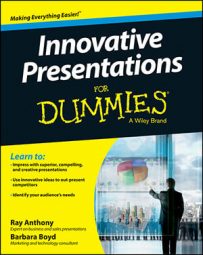You establish credibility when you communicate directly from your innovative presentation audience’s perspective, priorities, and positions regarding your topic. These analysis factors enable you to customize and tailor your presentation in ways that increase your chances of success. After you answer the following questions about your audience, you can begin to build a profile of the people your presentation caters to:
Group size: Find out how many people will be in attendance. This determines the resources you need, such as the number of handouts and sound reinforcement or other equipment, and what size meeting room best fits your needs and theirs.
Larger groups make individual engagement difficult. Smaller groups lend themselves to informal, casual interaction. You need to display more energy and typically have more attention-grabbing tactics to hold the interest of bigger audiences and to tone down the high-energy factor with small groups.
Knowledge and experience with your topic: What does the audience already know about your topic and how much do they know? If you talk over their heads, you’ll lose them. If your content is too basic, your group will quickly become bored, annoyed, and possibly insulted.
Your audience’s level of understanding of your topic also dictates the terminology you use, specifically whether you can employ technical or other specialized terms or acronyms. If your ideas or proposed solutions are new to your audience, you have to spend time building up to your main points so they understand the big picture and all the connecting points.
Opinions, feelings, and attitudes toward your topic: When your goal is to influence, motivate, or persuade people to do something, it’s critical that you discover what your audience’s likely stance toward your topic is and why.
Where do they stand intellectually and emotionally regarding your topic? Are people generally favorable, neutral, or negative? Can you discover the underlying reasons for why they feel skeptical, cynical, or cautious? With a friendly or neutral group, you can be more direct in advocating some course of action, but you have to be more subtle and indirect with a group somewhat hostile to your topic.
Needs, wants, and expectations: What does your group most need and want from your presentation in terms of specific type of information and at what level of detail? What assurances, commitments, or guarantees do they expect from you and your organization? Overall, what does your audience hope to get from you and your presentation? What would they likely see happening as a result of your talk?
Priorities and pain points: What are the two or three highest priority areas of information your group needs most to make the decision you want? What are the primary interests and concerns (some call them hot buttons) your information should address? What can you say that would likely prompt them to make a commitment?
What do they least want or need to hear about regarding your topic? What important pain points are they experiencing that your presentation’s solution would help them overcome? What fear or worry can you alleviate? These are vital questions to get answers to in your audience analysis.
Decision makers: Who attending your presentation can — and likely will — sign the check? Which people may be key advisors, recommenders, and influencers of decisions to be made as a result of your presentation?
If you can, find out how your group makes its decision — their specific process — and how they’ll make one regarding your presentation. What criteria (in priority order) do they use to make that decision? Understanding these issues helps you come up with a persuasion strategy for all the parties involved in the decision.
Position levels and professions: Do most of the people attending hold C-level, executive, and senior vice president positions or are they middle managers? What fields do they specialize in — sales, marketing, research and development, distribution, operations or other?
Obviously, with senior leaders you need to focus on the big picture with bottom-line results. With technical professionals, you need to get into greater detail and provide information relevant to their particular set of occupational needs.
Audience makeup: Other group characteristics that are helpful to know include the gender mix, education levels, average age, socio-economic level, and perhaps ethnic background and political leaning. These factors dictate the examples you use, the stories you tell, your vocabulary mix, the facts you provide, and the persuasive strategy you need to apply.
Potential problems from the audience: How might the audience react unfavorably to your talk or your call to action? What might they disagree with or be cynical or skeptical about? What could make them feel uneasy and unsure? With what objections or tough questions might they ask to challenge you?
Determine what possible misinformation, unrealistic expectations, and faulty perceptions or assumptions need to be dealt with and how. What other forms of direct or silent resistance might affect reaching your planned results? Can you identify those likely to oppose your plan or solution? How can you best deal with these threats to your presentation goals?
Mood and condition of group: The emotional, mental, and physical state of your audience can dramatically affect their receptivity, decision making, and participation. If your presentation is scheduled for 3 p.m. on Friday after the group has sat through four other presentations that day, you may have a challenge on your hands, compared to speaking to them on a Tuesday morning when they’re fresh and alert.

